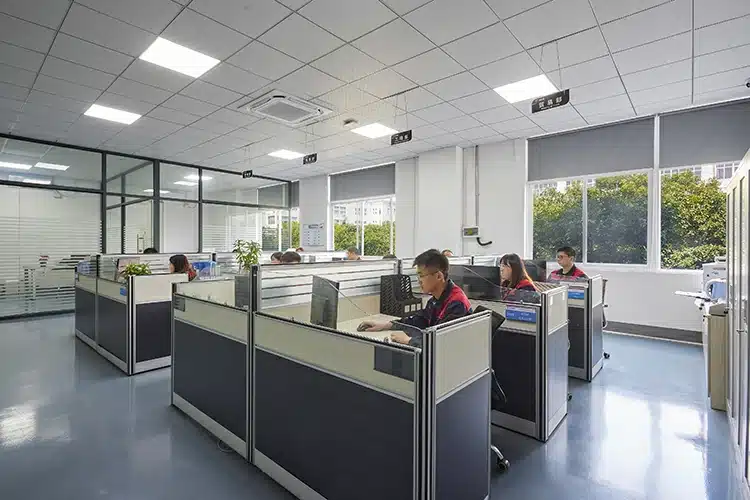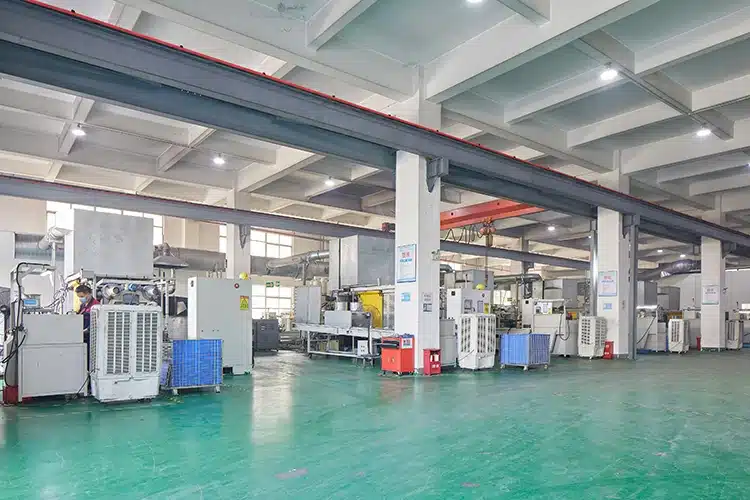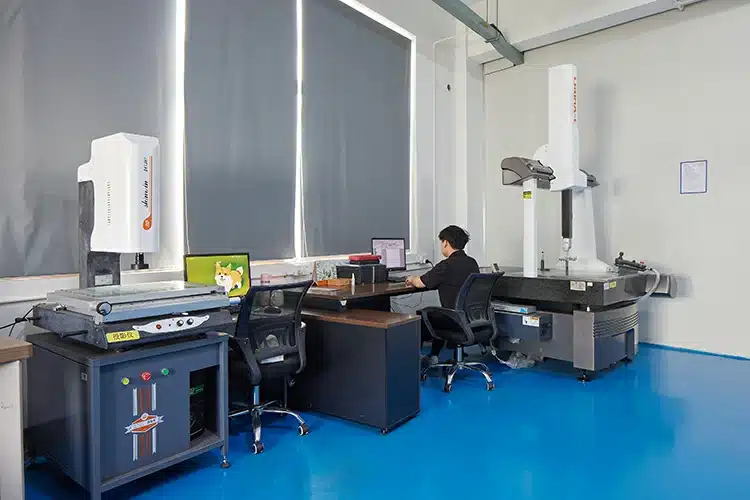Warm kamer spuitgietwerk
Hot chamber die casting is a die casting process specially used for low melting point or non-ferrous metals, such as zinc, magnesium alloys, etc. In the hot chamber die casting process, part of the die casting machine is heated, and the casting material is preheated inside the machine and then fed into the mold through pressure. The mold is then rapidly cooled and solidified.
The advantage of hot chamber die casting is that it can produce high-quality and high-precision parts with high productivity. In addition, because hot chamber die casting uses preheated metal liquid, it can better fill the details of the mold, thereby reducing the occurrence of blisters, bubbles and other defects.
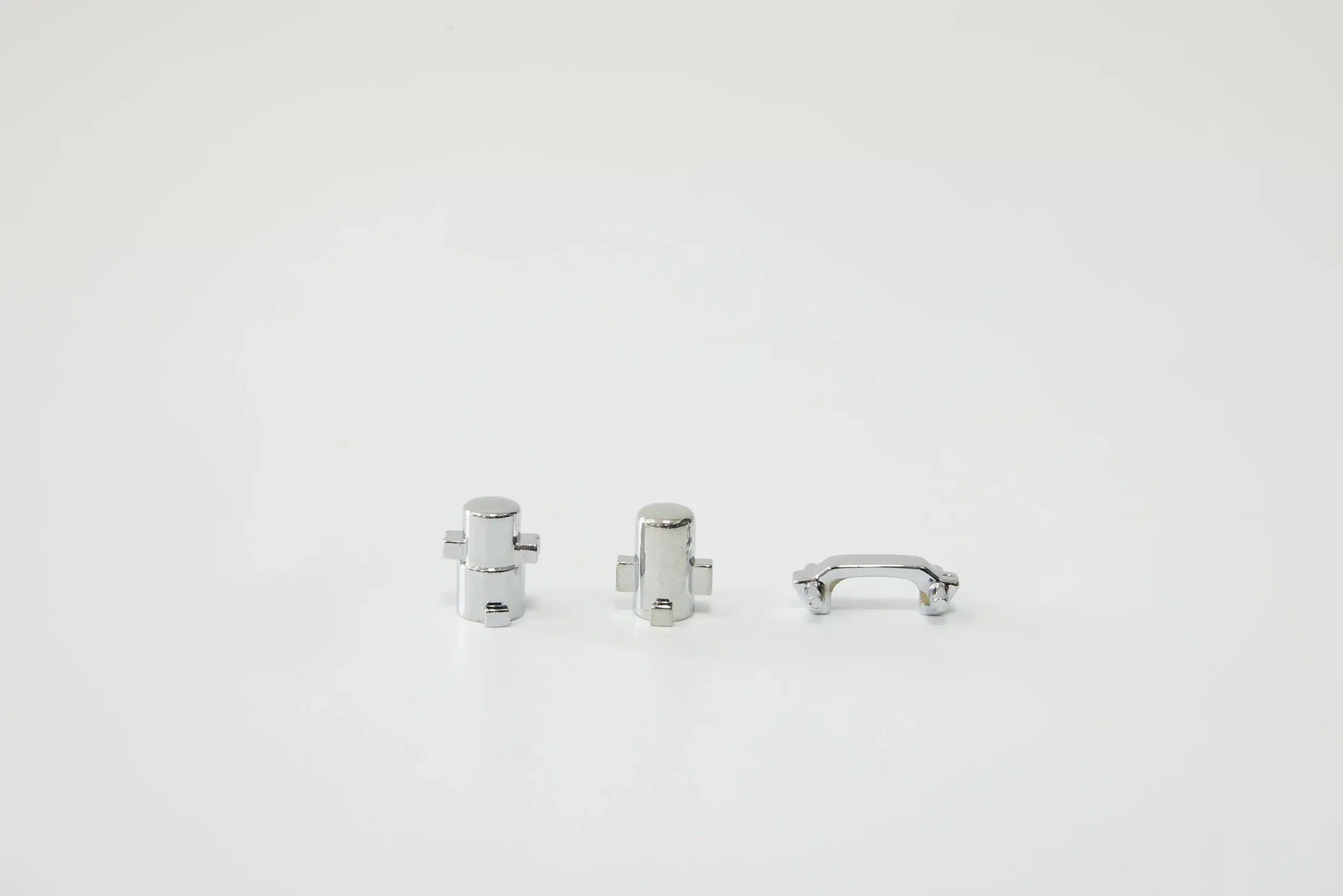
What is hot chamber die casting?
Hot chamber die casting is a widely used metal casting process, especially suitable for processing low-melting-point materials such as zinc and magnesium. Hot chamber die casting is a manufacturing process in which molten metal is injected into a mold at high pressure and then rapidly cooled and solidified to form precise and complex shapes. This technology utilizes the special design of a hot chamber die-casting machine, which allows the metal to be preheated before being injected into the mold and to achieve precise filling and shaping under high pressure.
Process principle
The main part of a hot chamber die casting machine is a heated die casting chamber, also known as the “hot chamber.” This hot chamber is maintained at the proper temperature to contain and hold the molten metal. When the die casting machine is started, molten metal is injected into the hot chamber and injected into the mold at high pressure through a nozzle or injection system. The mold is usually made of steel or other high-temperature resistant materials and is quickly cooled by a cooling system to ensure that the metal solidifies quickly in the mold.
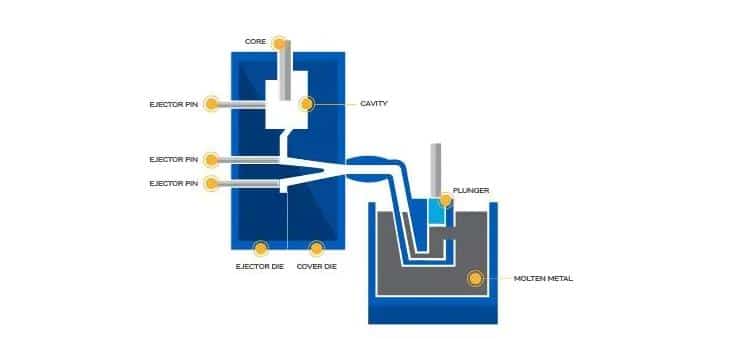
Cold chamber die casting and hot chamber die casting will be applied to materials
The mold core material uses hot-working mold steel, such as SKD61, DAC, DH-31, 8407, 8418, H13, 3Cr2W8V, 4Cr5MoSiV, 1.2344, W302, etc.
Most mold frames are made of cast steel, ductile iron, medium carbon steel, etc. For example QT550, QT600, S50C.
The Hot Chamber Die Casting Process
The hot chamber die casting process is a complex and precise metal casting process that involves injecting molten metal into a mold to produce precise and complex shapes. Through constant technological innovation and improvement, the hot chamber die casting process will continue to play an important role in the manufacturing industry and promote the development and progress of related industries. The following is a detailed introduction of the hot chamber die-casting process:
- Preparing the mold: In the hot chamber die casting process, the mold is critical. Molds are made of high temperature and wear resistant materials such as steel, copper or aluminum alloys. The design and manufacturing of molds need to be accurate to the micron level to ensure accurate filling and shaping of metal liquids.
- (Special reminder: When preparing the mold, you need to ensure that the surface of the mold is smooth and without defects or cracks. In addition, you also need to check whether the size and shape of the mold match the product requirements. If there are any problems with the mold, it needs to be repaired or replaced. )
- Molten metal: In the hot chamber die casting process, the metal liquid is key. Metal is heated above its melting point, causing it to become molten. This can be achieved by using heating devices such as induction coils or resistance furnaces. During the melting process, the temperature and composition of the metal need to be kept constant to avoid quality problems.
- Injecting the metal: When the metal liquid is ready, it is injected into the mold through the nozzle or injection system of the die casting machine. During the injection process, it is necessary to ensure that the metal liquid is injected into the mold at high pressure and high speed to achieve accurate filling and forming. At the same time, it is also necessary to control the temperature and flow rate of the metal liquid to avoid defects or cracks.
- Cooling and solidification: When the metal liquid is injected into the mold, it needs to be cooled and solidified. This is accomplished by cooling the mold to a lower temperature. During the cooling process, cooling speed and temperature gradient need to be controlled to avoid thermal stress or cracks. At the same time, it is also necessary to ensure that the metal is completely solidified to avoid defects such as shrinkage or pores.
- Demoulding and post-processing: After the metal has completely solidified, demoulding operations are required. This is done by opening the mold and taking out the metal product. During the demoulding process, the integrity of the metal products needs to be ensured and any damage avoided.
- Finally, the metal products need to be post-processed, such as grinding, polishing, painting, etc. These post-processing steps can further enhance the quality and appearance of your metal products. The above are the steps for the production of hot chamber die-casting products of Mindwell Company.
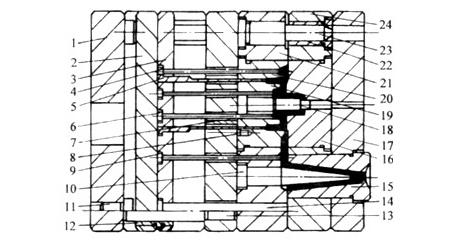
5 advantages of hot chamber die casting
Hot chamber die casting is a metal casting process that is widely used in various industries. The advantages of hot chamber die casting make it one of the first choices in various industries, especially in the fields of automobiles, electronics, aerospace and other fields. As technology continues to advance and innovate, the hot chamber die casting process will continue to play an important role and promote the development and progress of related industries. Its advantages include the following aspects:
- High production efficiency: Hot chamber die casting adopts continuous casting method, which can achieve efficient production. In the hot chamber die casting process, molten metal is injected into the mold through a nozzle under pressure, forming the desired shape, and then rapidly cooled and solidified. Since the entire process has a short cycle time and multiple casting processes can be completed in a short time, the production efficiency is very high.
- Cost savings: The hot chamber die-casting process can save raw materials and energy because only one melting process is required for multiple castings, reducing the number of melting and pouring, thereby reducing costs. Additionally, the hot chamber die casting process can reduce labor costs by automating operations.
Manufacturing complex parts: The hot chamber die casting process can produce parts with complex shapes and structures, such as small holes, bumps and depressions. This makes hot chamber die casting uniquely advantageous in manufacturing certain precision parts. - Optimized design: Since the hot chamber die casting process can produce complex shapes and structures, more optimization can be done during the design stage to improve the performance and appearance quality of the product.
- Environmentally friendly and sustainable: The hot chamber die-casting process can reduce the generation of waste materials because the metal utilization rate is high, which reduces the generation of cutting, residual materials and other waste materials. In addition, environmentally friendly energy and materials can be used in the hot chamber die-casting process, such as the use of renewable energy and environmentally friendly paints, thereby reducing the impact on the environment.
- Improve product quality: The hot chamber die casting process can reduce the occurrence of casting defects, such as pores, shrinkage holes and other problems. At the same time, since the entire casting process can be completed in a short time, the time the metal stays at high temperatures is reduced, thereby reducing the possibility of oxidation and other chemical changes and improving the quality of the product.
Industry Applications
Hot chamber die casting, as an efficient metal casting process, is widely used in many industries. From automotive components to consumer electronics, hot chamber die casting makes a significant contribution to the production of critical components for these industries.
- In the automotive industry, hot chamber die casting is widely used to manufacture various components, such as engine parts, chassis parts, brake system parts, etc.
- It also has a wide range of applications in the field of consumer electronics. For example, the shells, buttons, brackets and other components of mobile phones, computers, tablets and other products can be manufactured through the hot chamber die casting process.
- In aerospace, for example, aircraft engine parts in aerospace.
- Surgical instruments in medical device field.
- Building structural parts in the field of construction, etc.
These parts often require high strength, corrosion resistance and light weight, and the hot chamber die casting process meets these requirements. At Mnwell, the products cast by our hot chamber die casting machines are widely used in many industries. Its versatility allows it to adapt to the needs of different industries, making an important contribution to the production of critical components.
Cold chamber die casting and hot chamber die casting


Cold chamber die casting and hot chamber die casting are two different die casting processes, which differ in terms of application scope, material selection, production efficiency and environmental protection requirements.
Material choice
Cold chamber die casting is suitable for metals with high melting points, such as copper, aluminum, zinc, etc. Due to the higher melting points of these metals, cold chamber die casting requires heating the metal to a higher temperature in order to cast it. As a result, cold chamber die casting equipment is typically larger and requires more energy to heat. Hot chamber die casting is suitable for low melting point and special metals, such as magnesium and titanium. These metals have low melting points so they can be cast without the need for heating equipment.
Scope of application
Because cold chamber die casting processes the metal liquid more carefully, the parts it casts generally have greater strength and wear resistance. In addition, cold chamber die casting is suitable for the production of large or complex metal components because its equipment can withstand greater pressure and temperature changes.
Hot chamber die-casting equipment is relatively small and the operation is more flexible. At the same time, because the metal liquid in hot chamber die casting has a higher temperature, it has better fluidity and can better fill the details of the mold. Therefore, hot chamber die casting is suitable for the production of high-quality and high-precision parts and is suitable for the production of smaller and fine metal products.
Environmental requirements
In terms of environmental protection, cold chamber die casting does not need to heat the equipment, so its energy consumption is relatively small, more energy-saving and environmentally friendly. Hot chamber die-casting requires preheating of the equipment, and the production process will generate a certain amount of exhaust gas and smoke, so manufacturers are required to equip corresponding environmental protection facilities.
In summary, cold chamber die casting and hot chamber die casting each have their advantages and scope of application. When choosing, we need to consider factors such as materials, component size, production efficiency, and production environment to choose the most suitable die-casting process.
Contact Mindwell to start custom hot chamber die casting parts
What are the limitations of hot chamber die casting?
The limitations of hot chamber die casting mainly include the following aspects:
- Cost-effective only for high-volume production.
- High melting point metals cannot be used.
- High pressure range is required.
- Metals have low mobility, thus limiting product complexity.
- Heat treatment issues.
- Ejection marks and a small amount of burrs may remain on the mold separation line.
Which material is used in hot chamber die casting process?
In the hot chamber die-casting process, commonly used materials include non-ferrous metals and light metals such as aluminum alloy, zinc alloy, copper alloy, and magnesium alloy. These materials have the characteristics of low melting point, good fluidity, and easy processing, making them suitable for hot chamber die casting processes.
- Aluminum alloy has the advantages of low density, high specific strength, and good corrosion resistance, and is suitable for manufacturing lightweight and high-strength components;
- Zinc alloy has the characteristics of low melting point, good fluidity and easy processing, and is suitable for manufacturing small and thin-walled parts;
- Copper alloy has the advantages of good electrical conductivity, thermal conductivity, and corrosion resistance, and is suitable for manufacturing electrical components and wear-resistant parts.
During the hot chamber die-casting process, it is also necessary to select appropriate materials and alloy compositions based on the specific die-casting process and mold design requirements.
For parts requiring high strength and high toughness, materials such as aluminum alloy or zinc alloy can be selected; for parts requiring high electrical conductivity and high thermal conductivity, materials such as copper alloy can be selected.
At the same time, it is also necessary to select the appropriate alloy composition and melting process according to the mold design requirements to ensure the stability and reliability of the die casting. When selecting hot chamber die-casting materials, you need to consider the product’s usage requirements, processing performance, cost and other factors, as well as the specific die-casting process and mold design requirements, and select appropriate materials and alloy compositions.
Why is aluminum not good for hot chamber die casting?
The main reason why aluminum is not suitable for hot chamber die casting is its low melting point, only about 660°C, while the melting point of aluminum alloys is usually above 500°C. Due to its low melting point, aluminum needs to be heated to high temperatures to make it liquid, which is detrimental to the die-casting process.
Hot chamber die casting machines usually use metals such as zinc, tin, and lead as materials because these metals have relatively high melting points and can be die cast at lower temperatures. In addition, the hot chamber die casting process is usually used for die casting small castings, because large castings require higher pressure and longer cooling time, and the hot chamber die casting machine has limited pressure and cooling capabilities.
It should be noted that if aluminum or aluminum alloys are to be used for die casting, the cold chamber die casting process may be considered. Cold chamber die casting machines often use higher pressures and longer cooling times to produce high-quality aluminum parts.
Mindwell is a professional die cast manufacturer
Mindwell is a professional die-casting solution provider, providing hot chamber die casting and cold chamber die casting processes.
Mindwell has a professional technical team that provides customers with full-process services from product design, mold manufacturing to die casting production. At the same time, the company also pays attention to technological innovation and equipment maintenance to ensure that it provides customers with the highest quality products and services.
